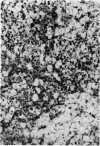Abstract
Toxicologic diseases of man and animals, associated with molds growing on foods, have been recognized for centuries. Only in recent years, however, have these mycotoxicoses received the attention of many laboratories and skilled scientists around the world in a broad inter-disciplinary effort.
This review covers the literature on mycotoxicoses but centers on those about which most is known, particularly the diseases associated with metabolites elaborated by some strains of Aspergilli, Penicillia, Fusaria, Stachybotrys, and Claviceps.
The ubiquitous nature of the aflatoxins, toxic metabolites produced by Aspergillus flavus, make them important to public health, especially since it is now known that certain areas of endemic liver disease coincide with consumption of aflatoxins and, often, malnutrition.
The older disease of ergotism, the scourge of Europe for centuries, is considered in detail. Alimentary toxic aleukia, which has caused enormous suffering in Russian human and animal populations, is better understood as a result of relatively recent experimental investigations. Stachybotryotoxicosis, a disease previously considered to be of significance only to man has now been identified in domestic animals.
Finally, Japanese studies have clearly revealed the hepatotoxicity of certain metabolites of Penicillium molds.
Factors that influence susceptibility to mycotoxins and the hazards they present to man are also reviewed.
Full text
PDF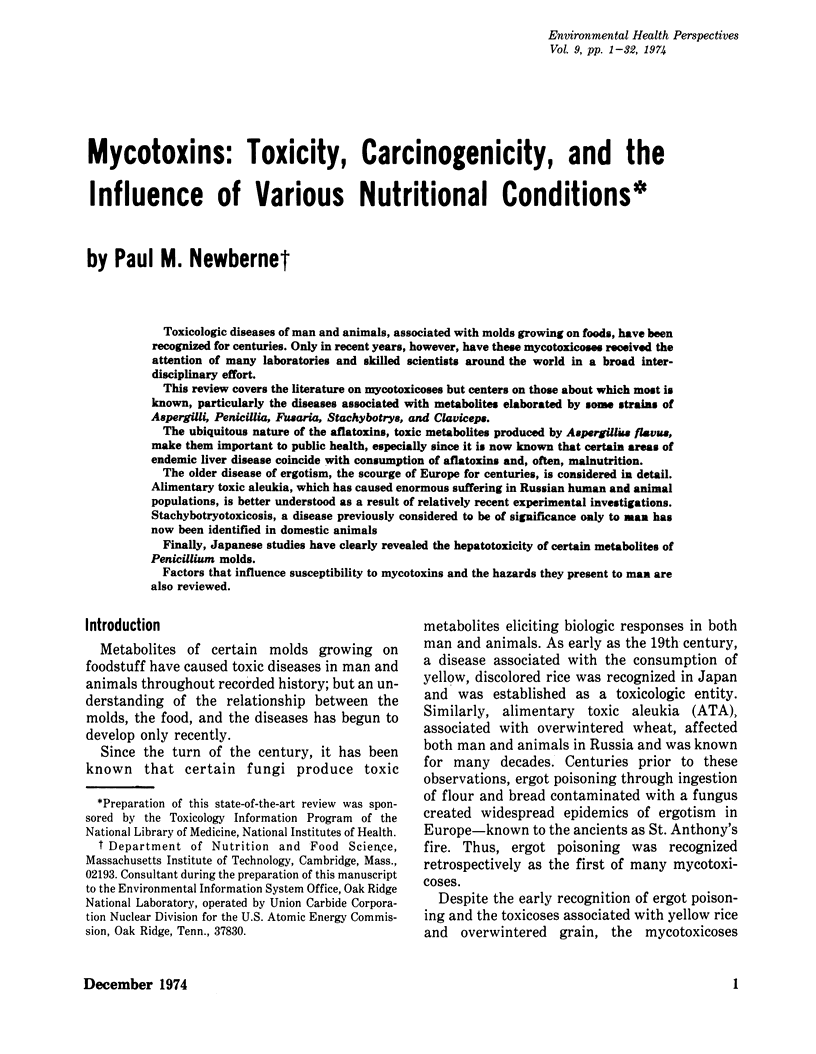
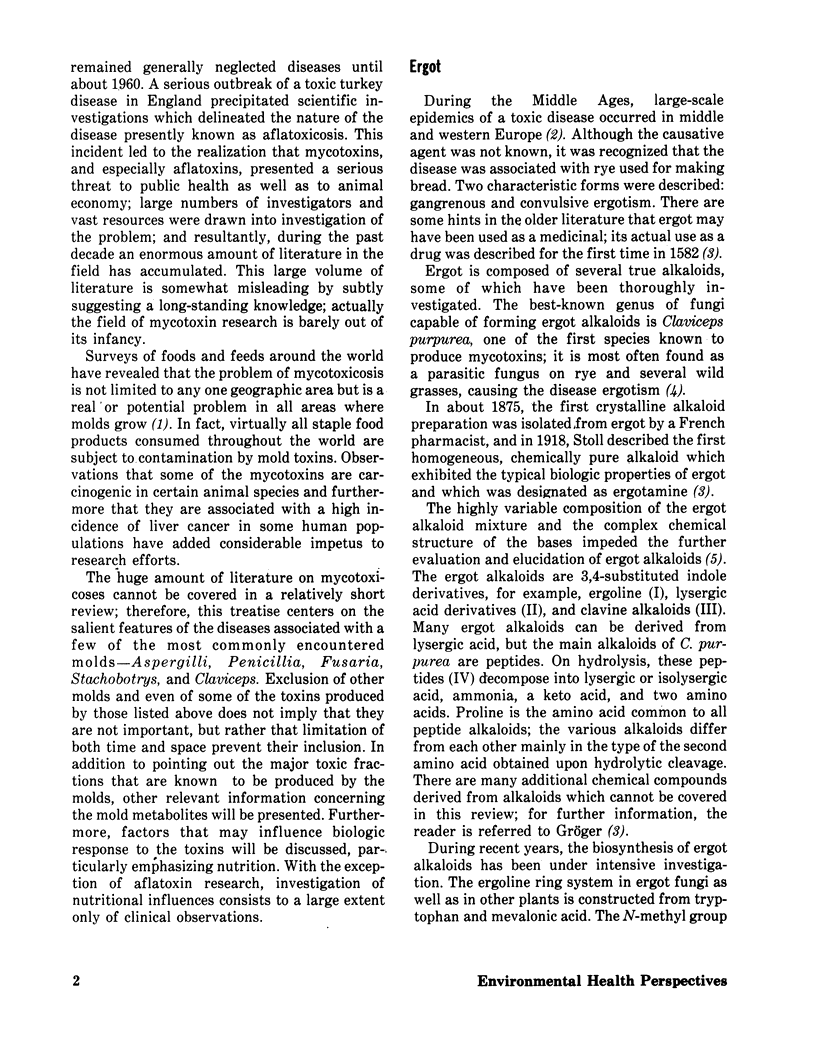
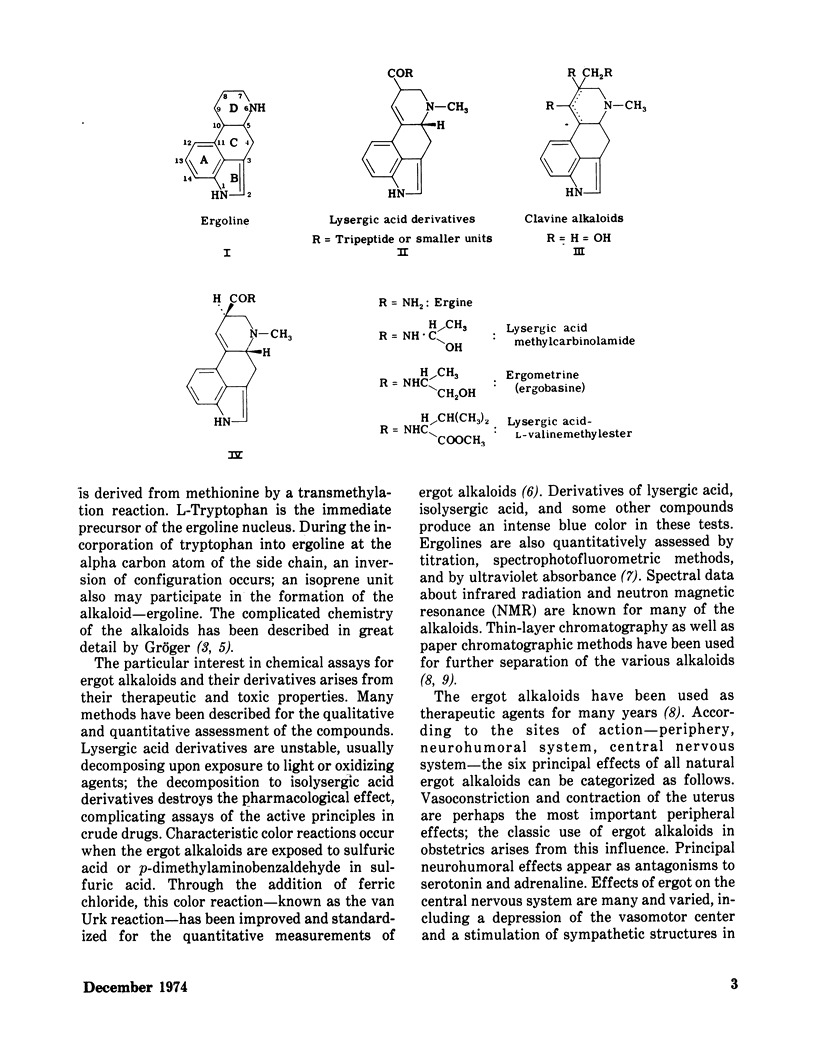
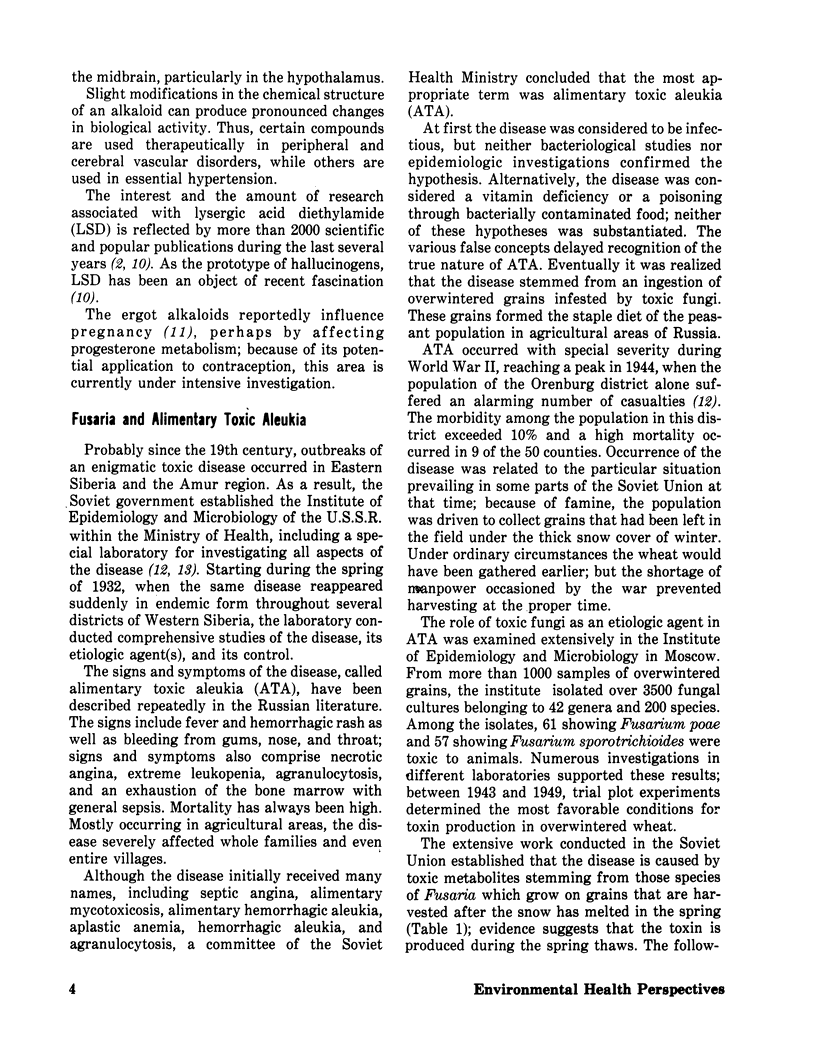
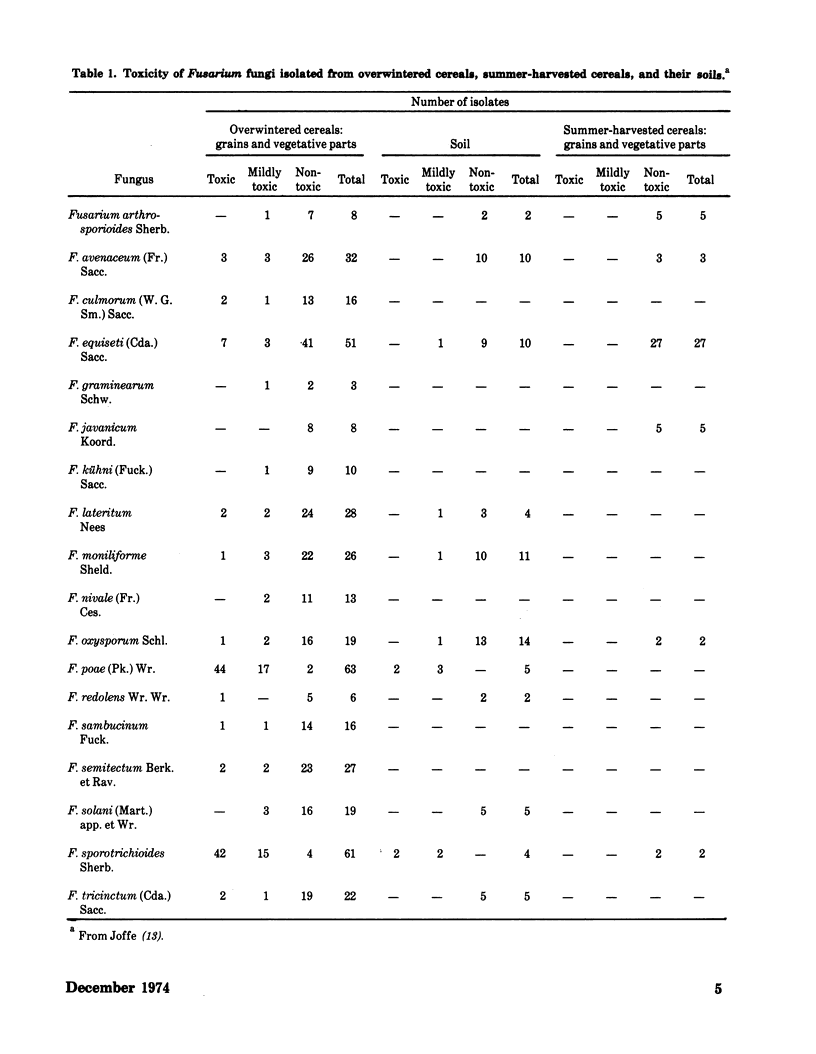
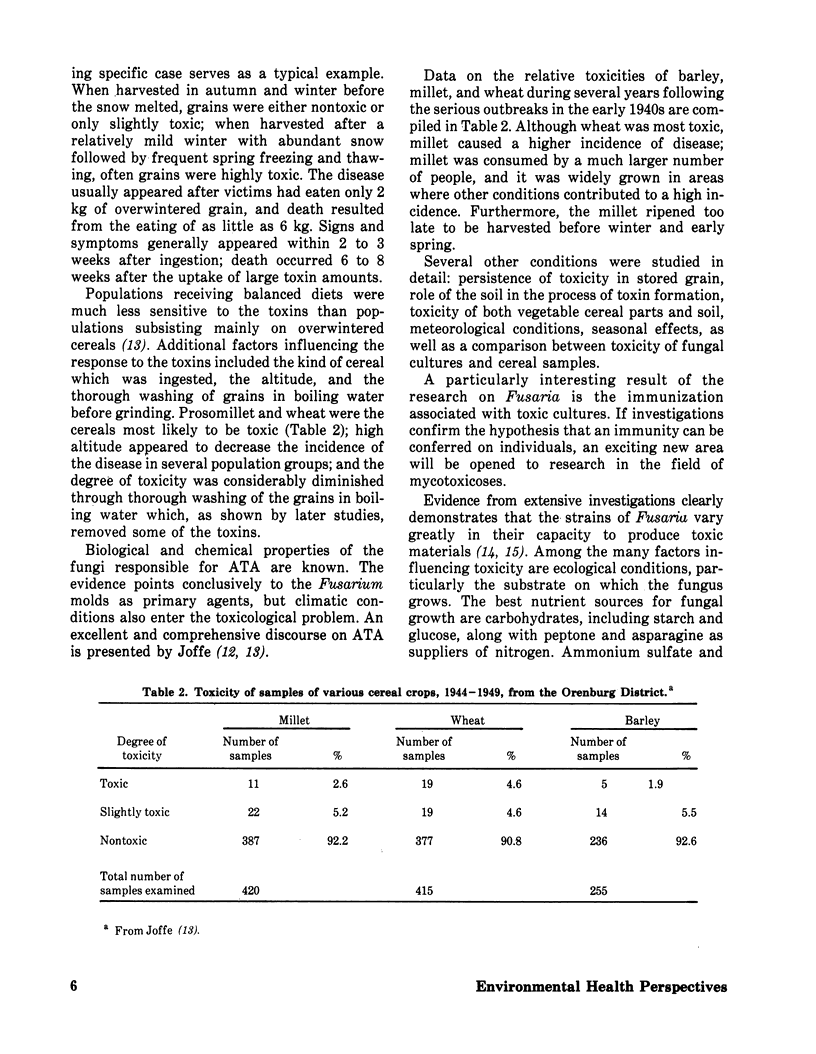
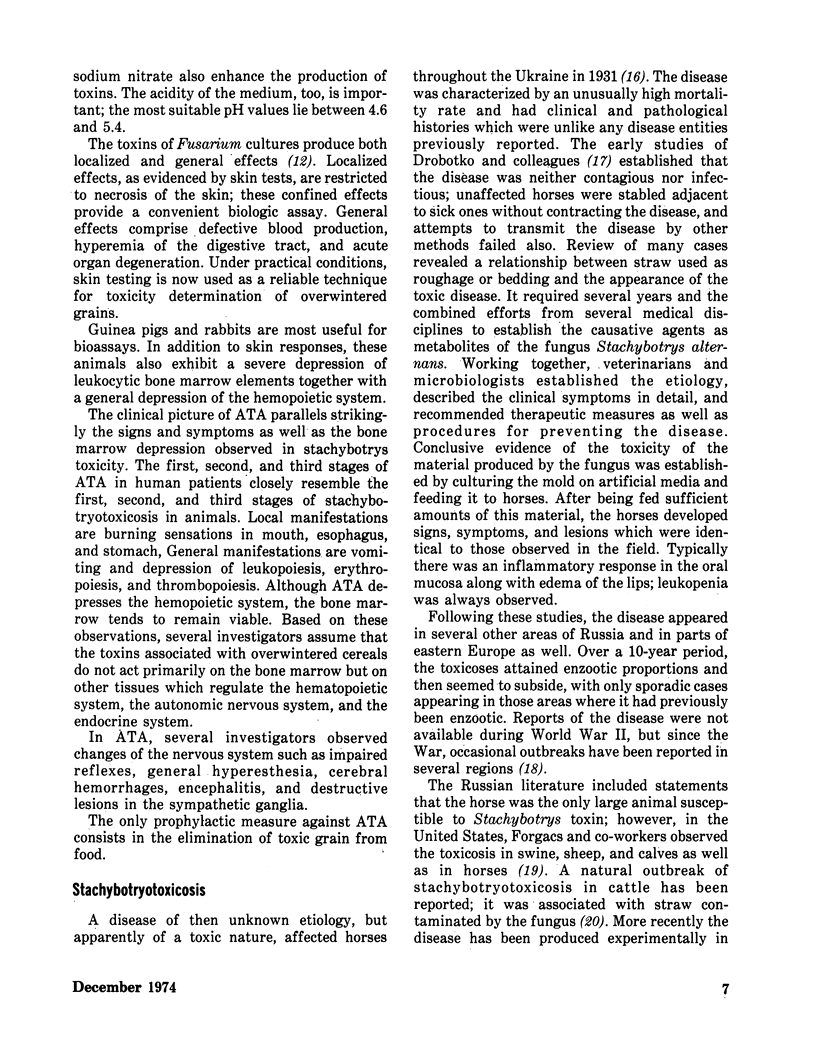
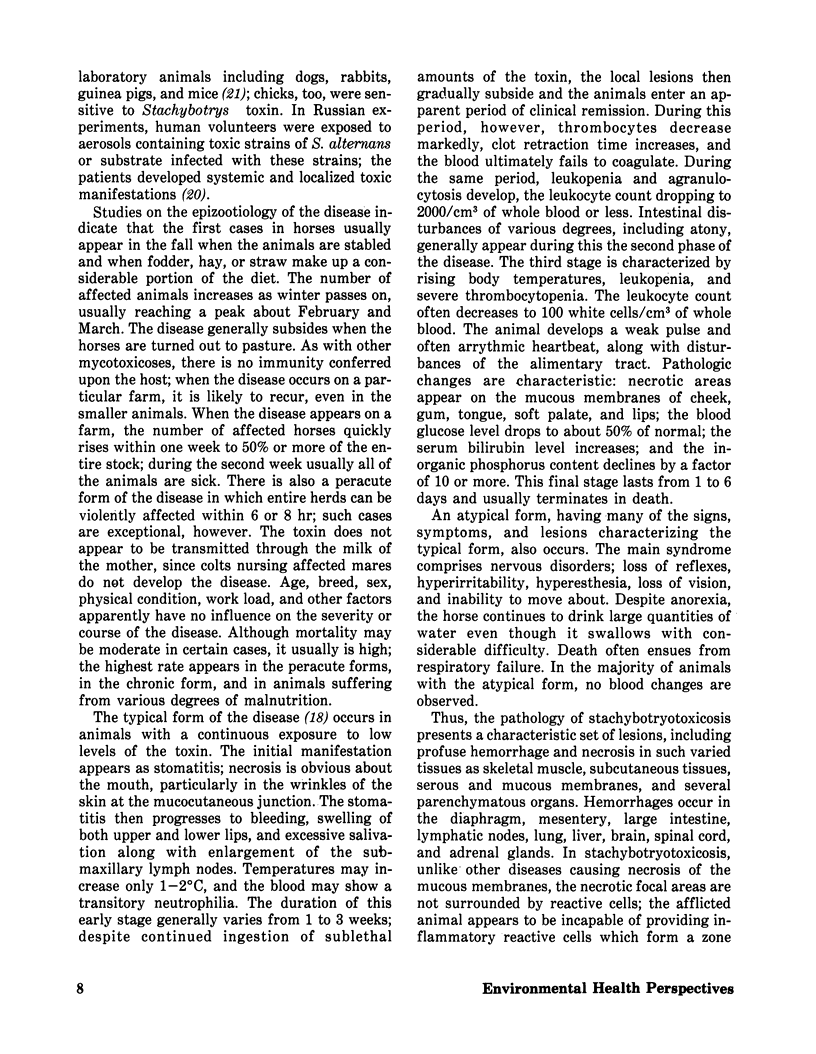
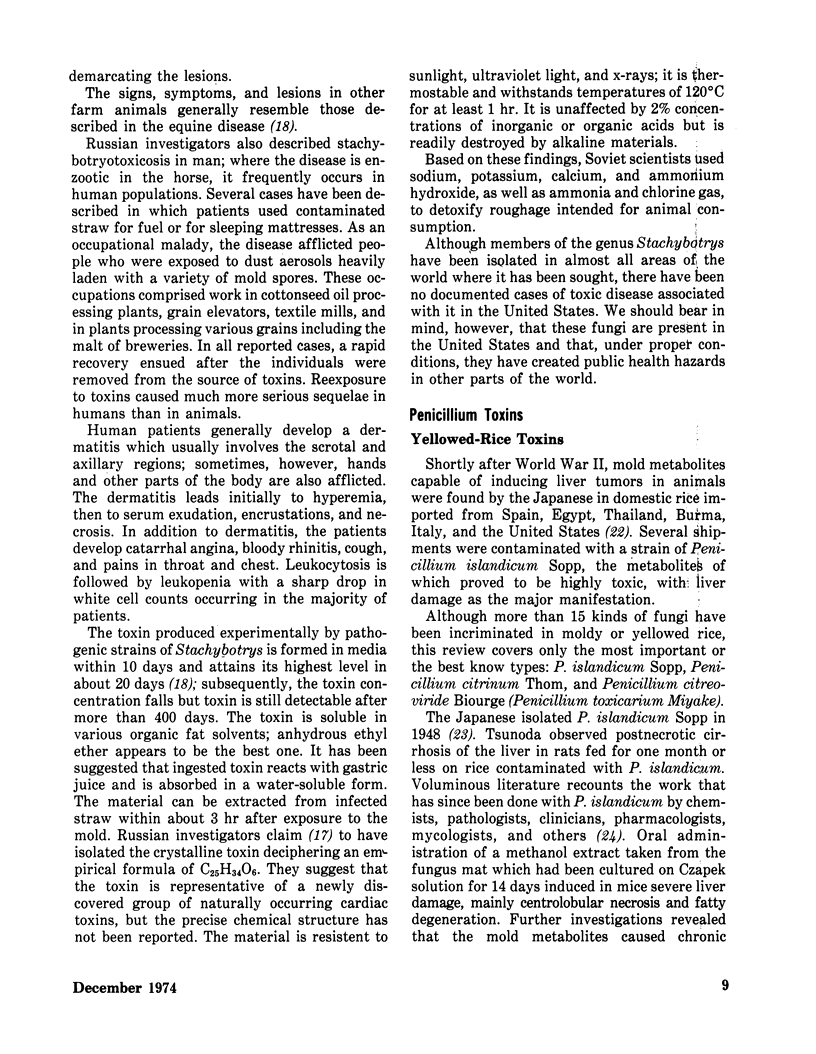
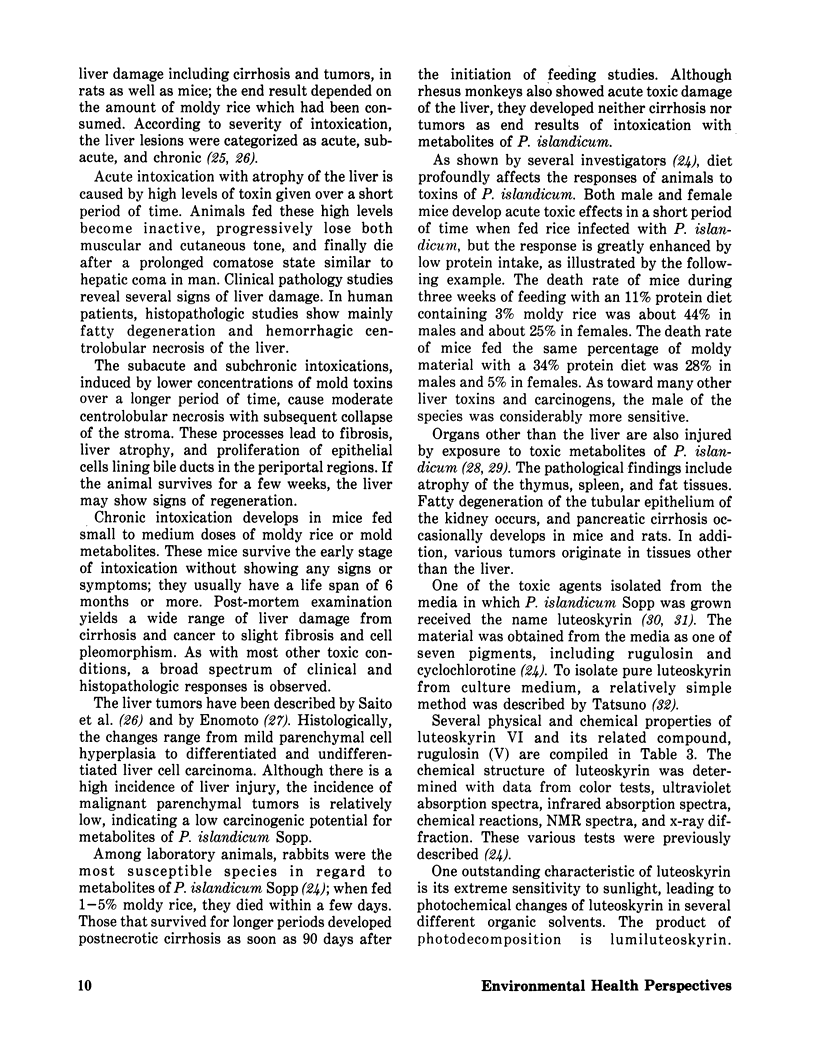
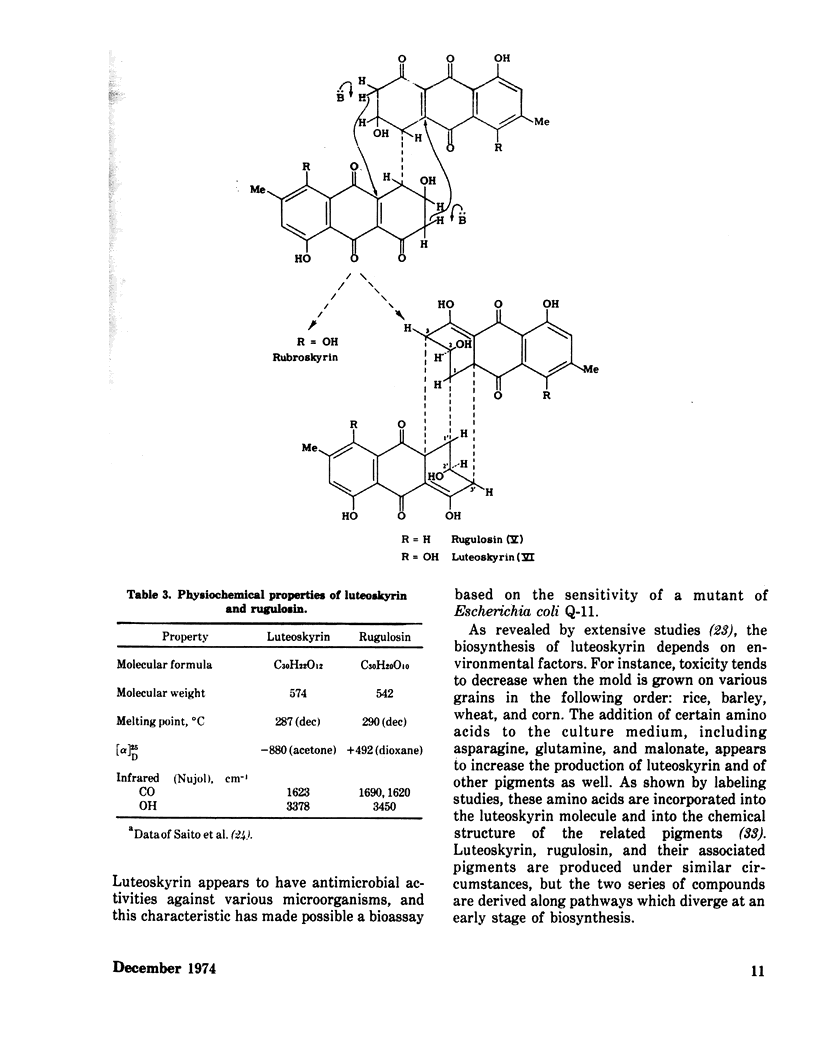
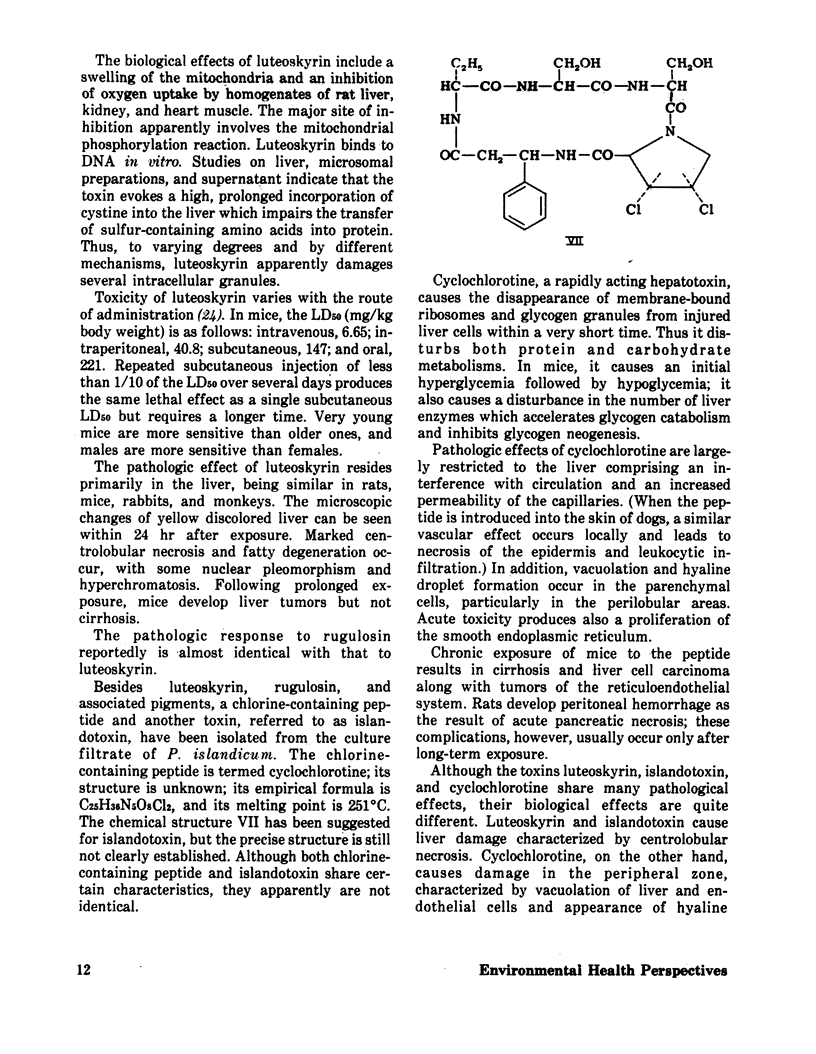
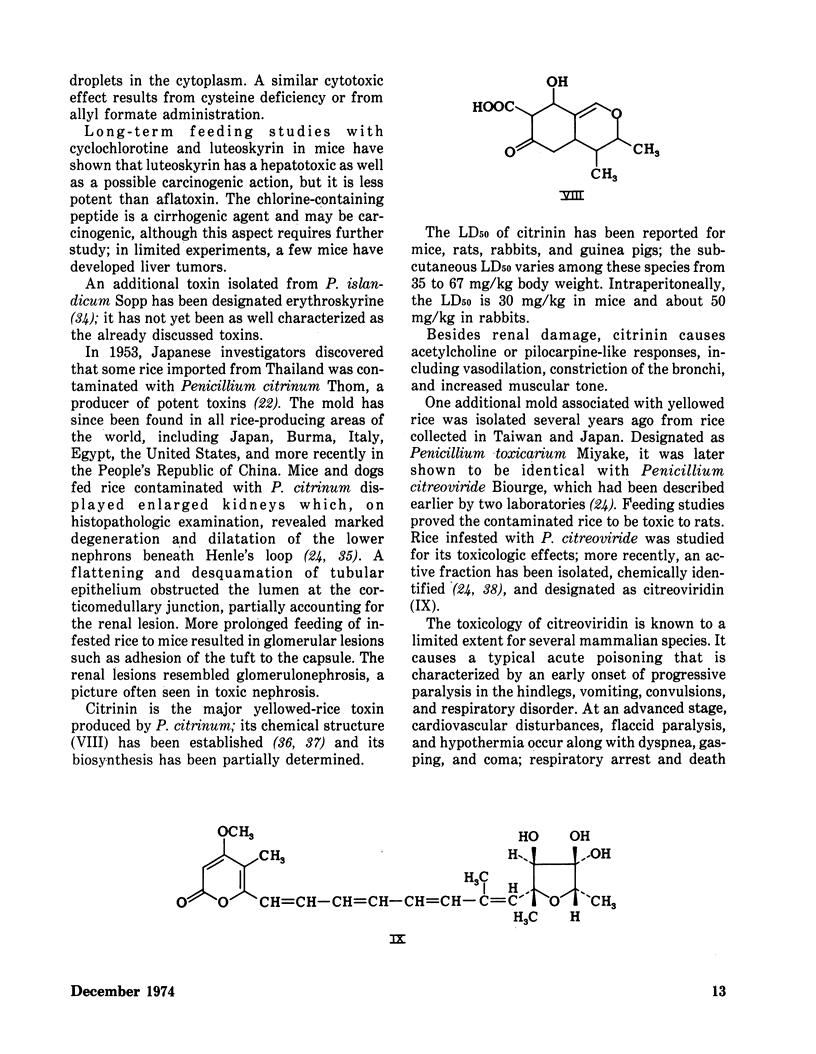
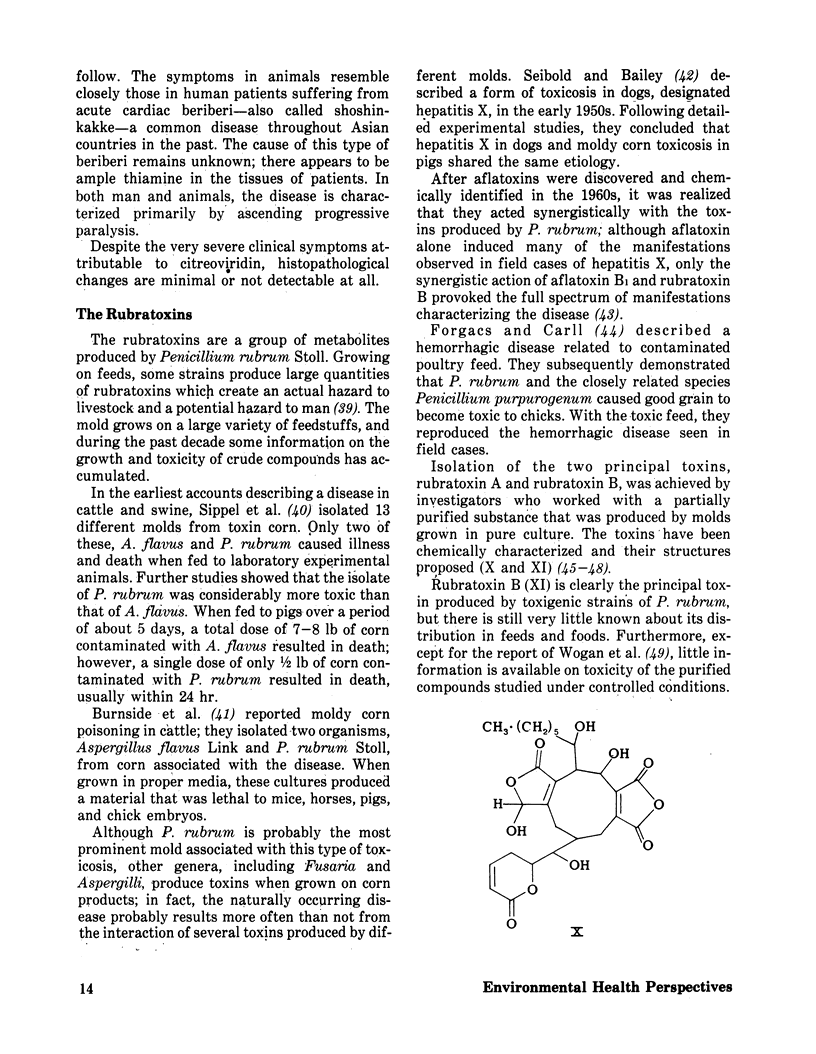

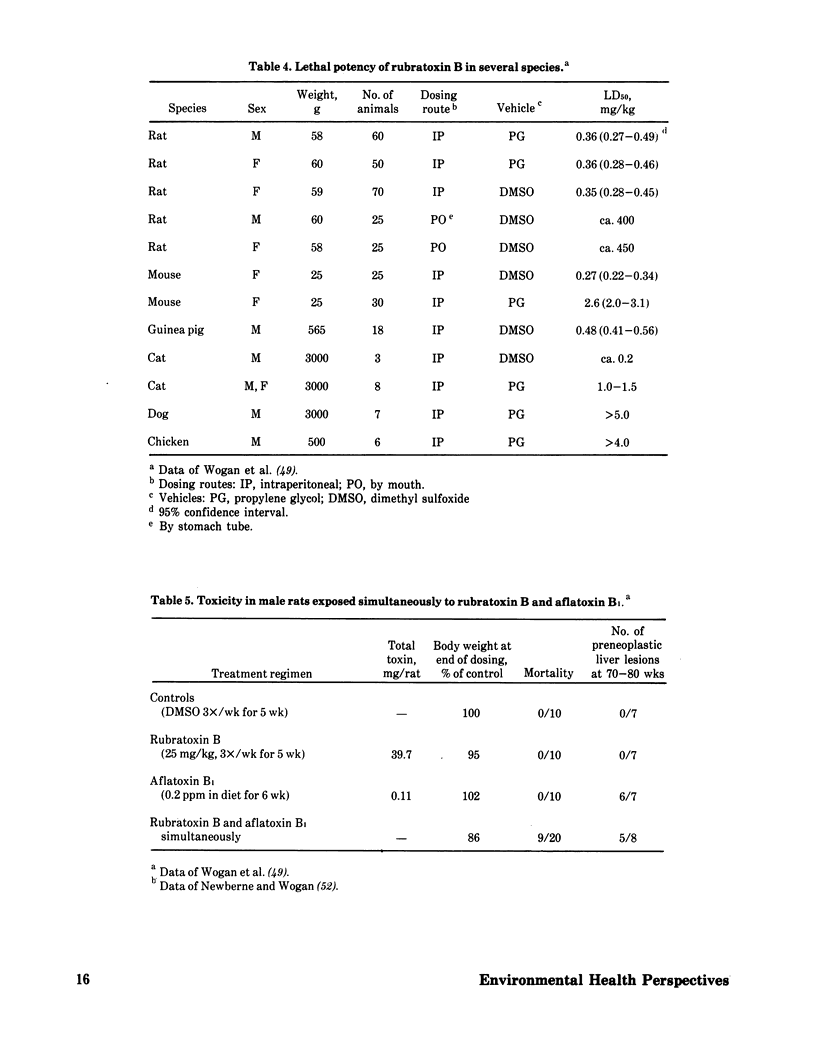
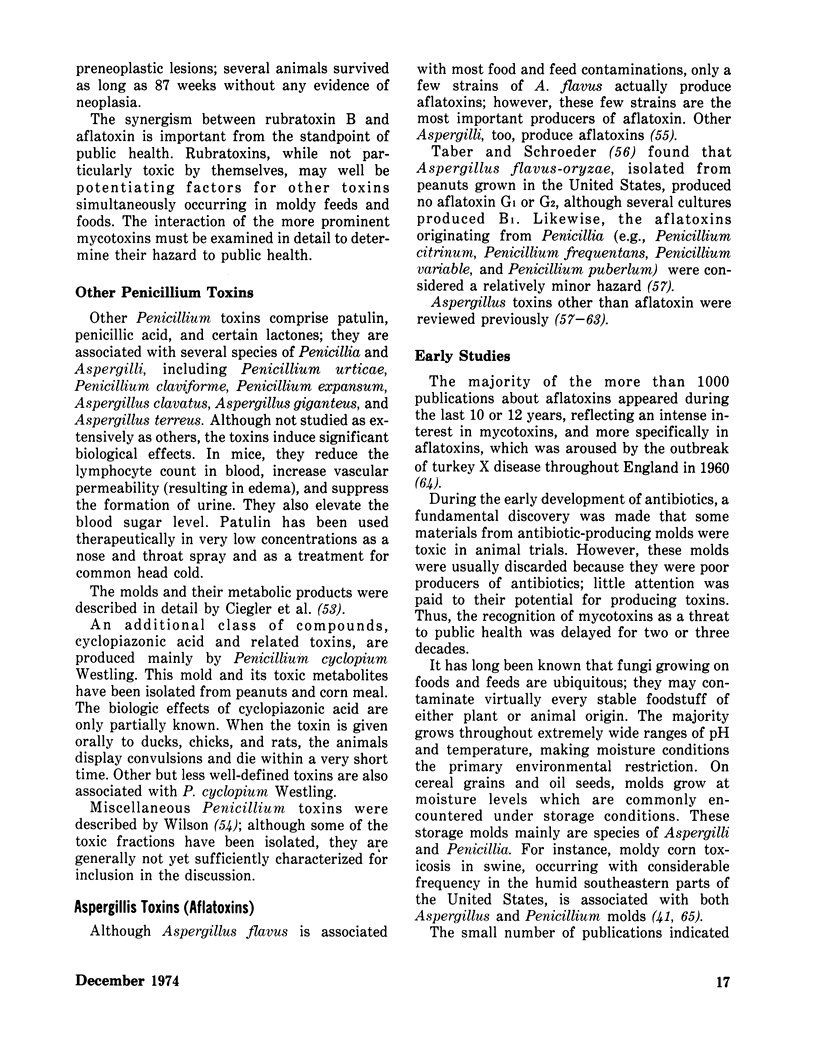
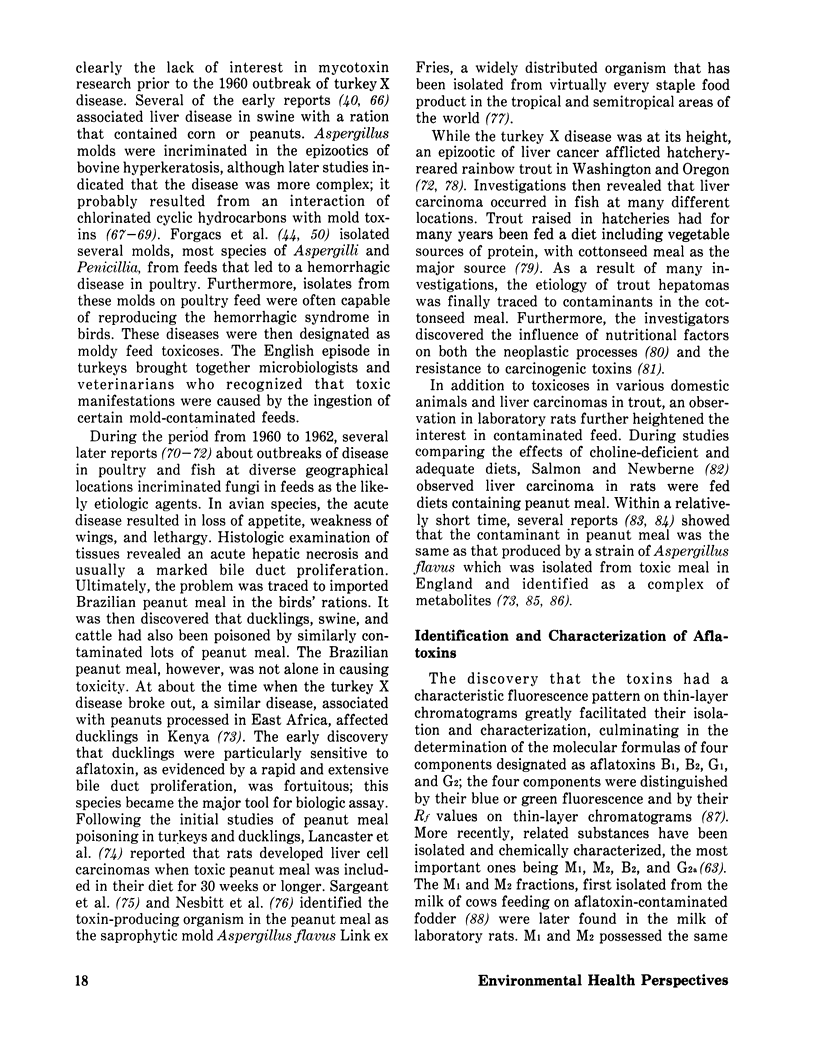
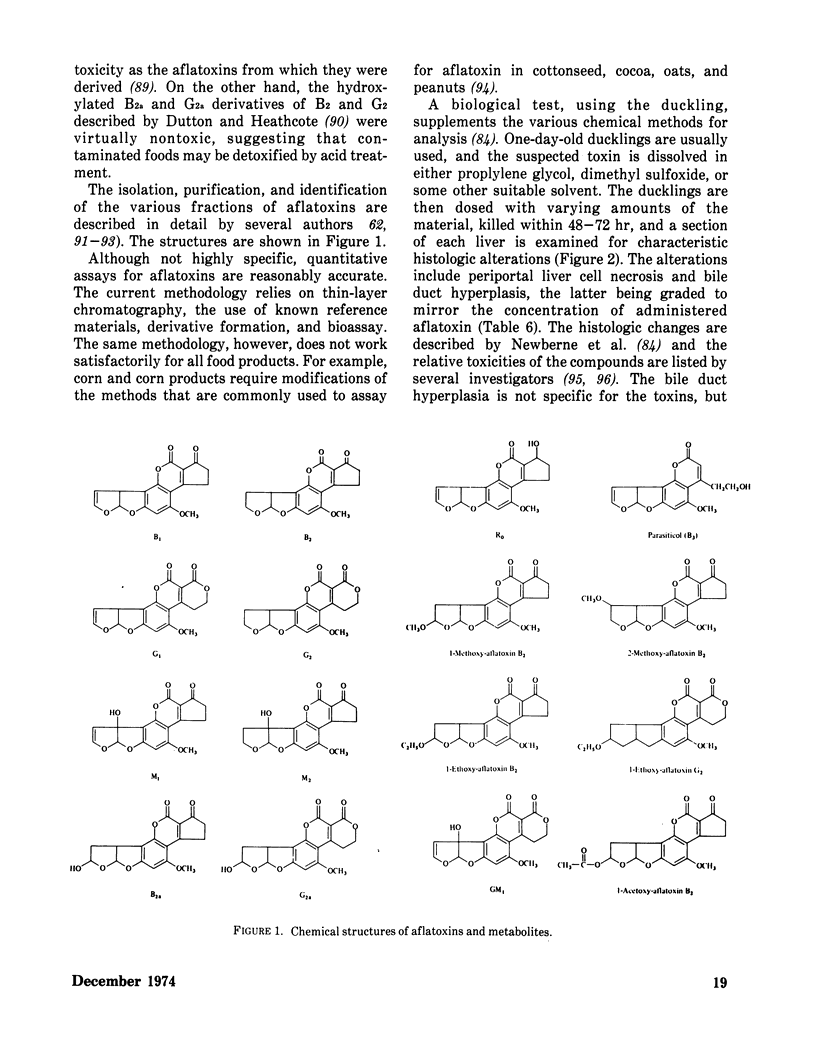
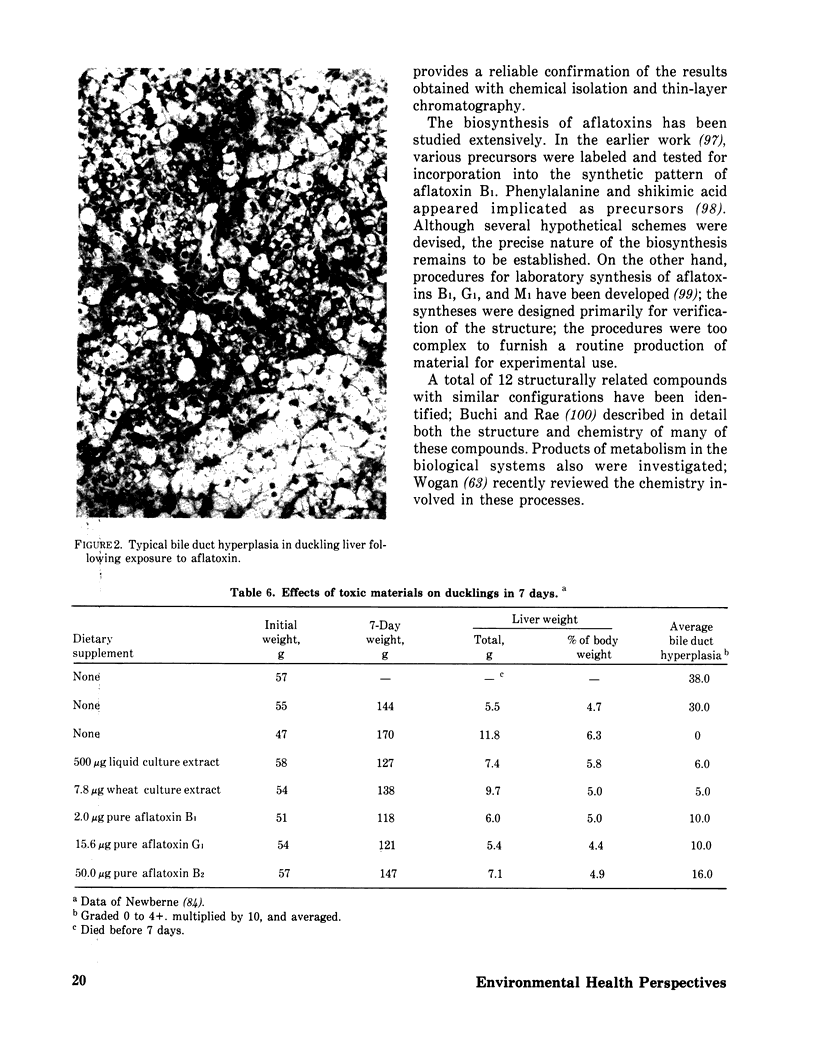

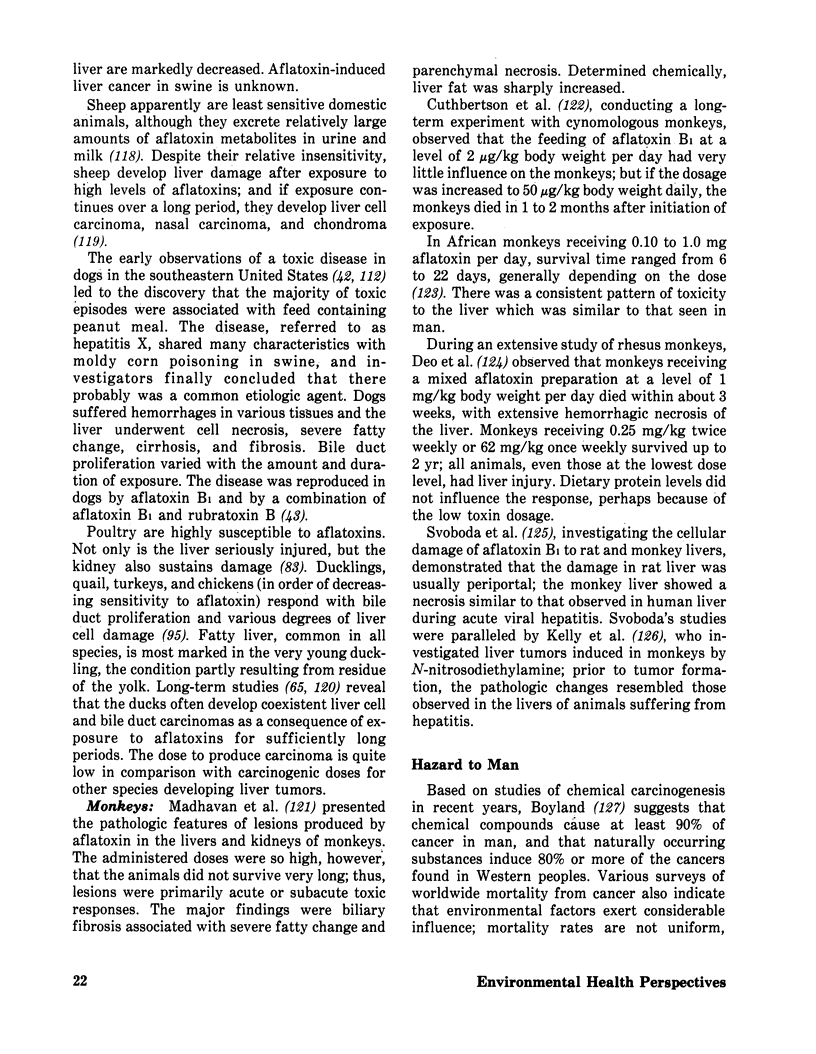
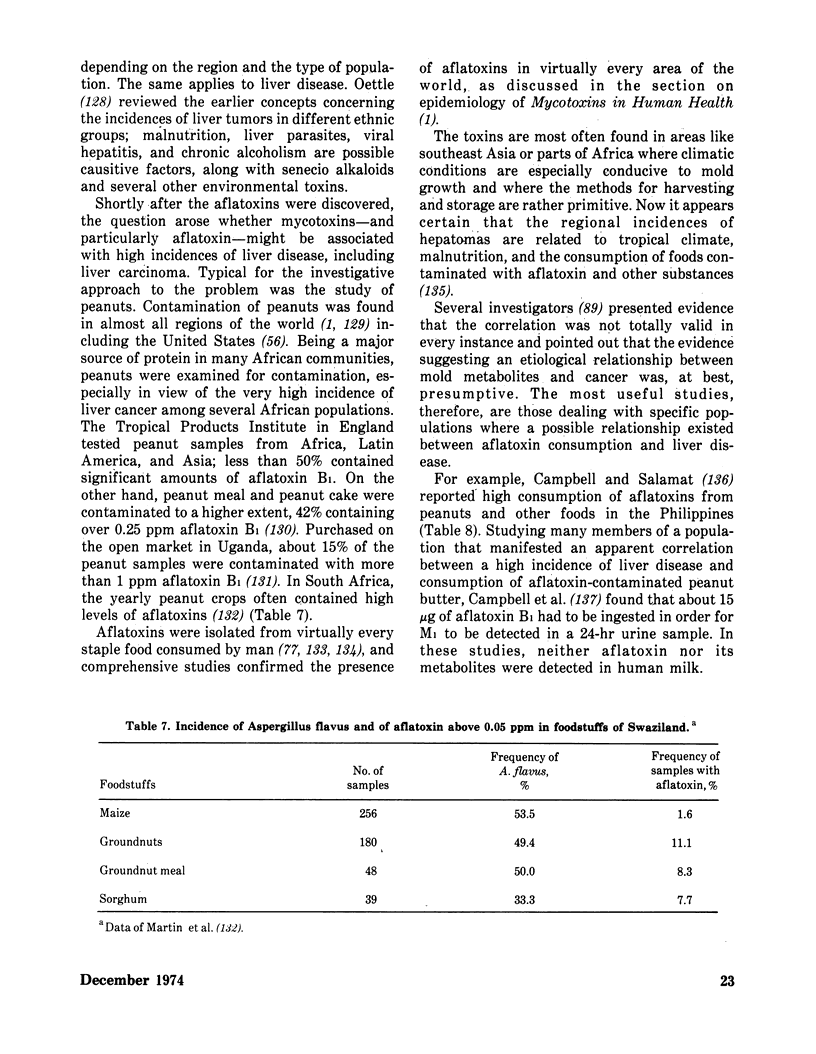
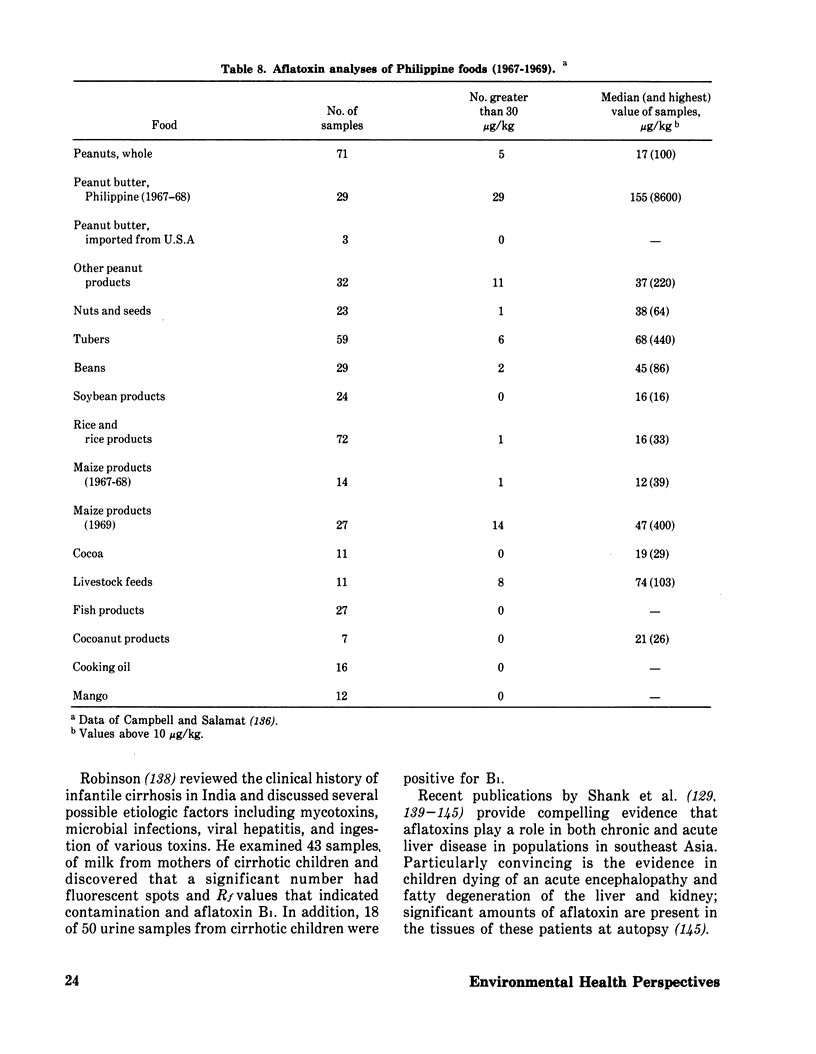
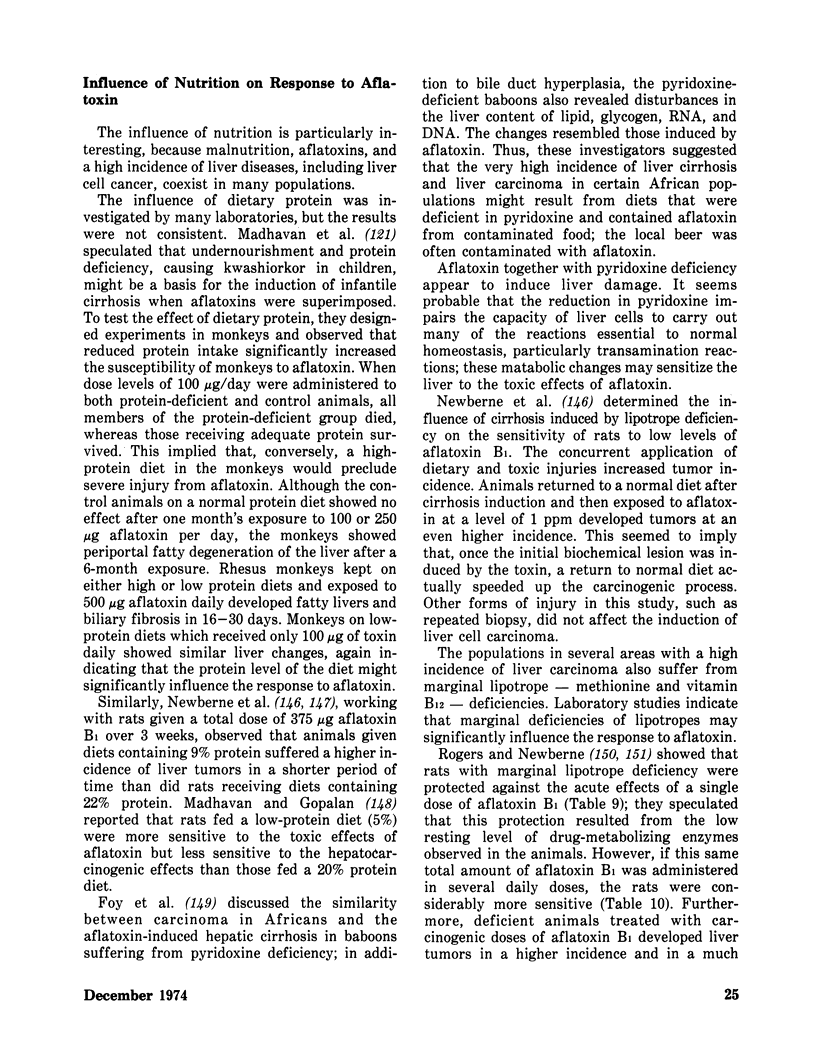
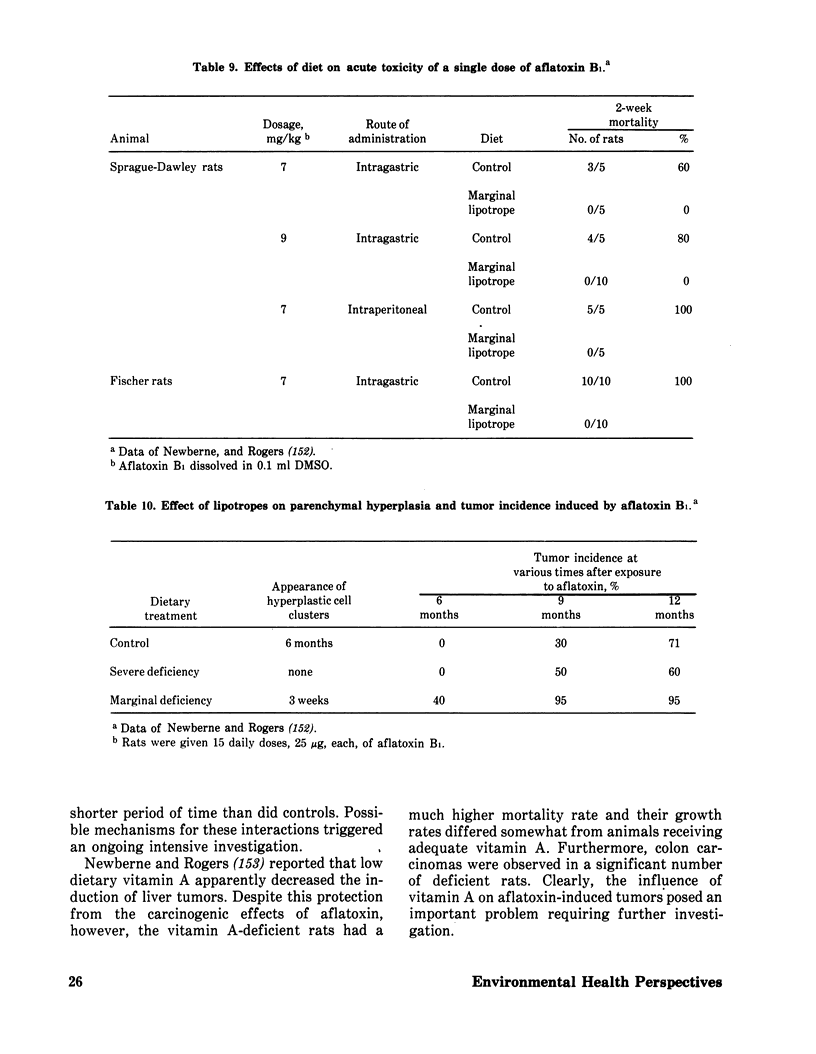
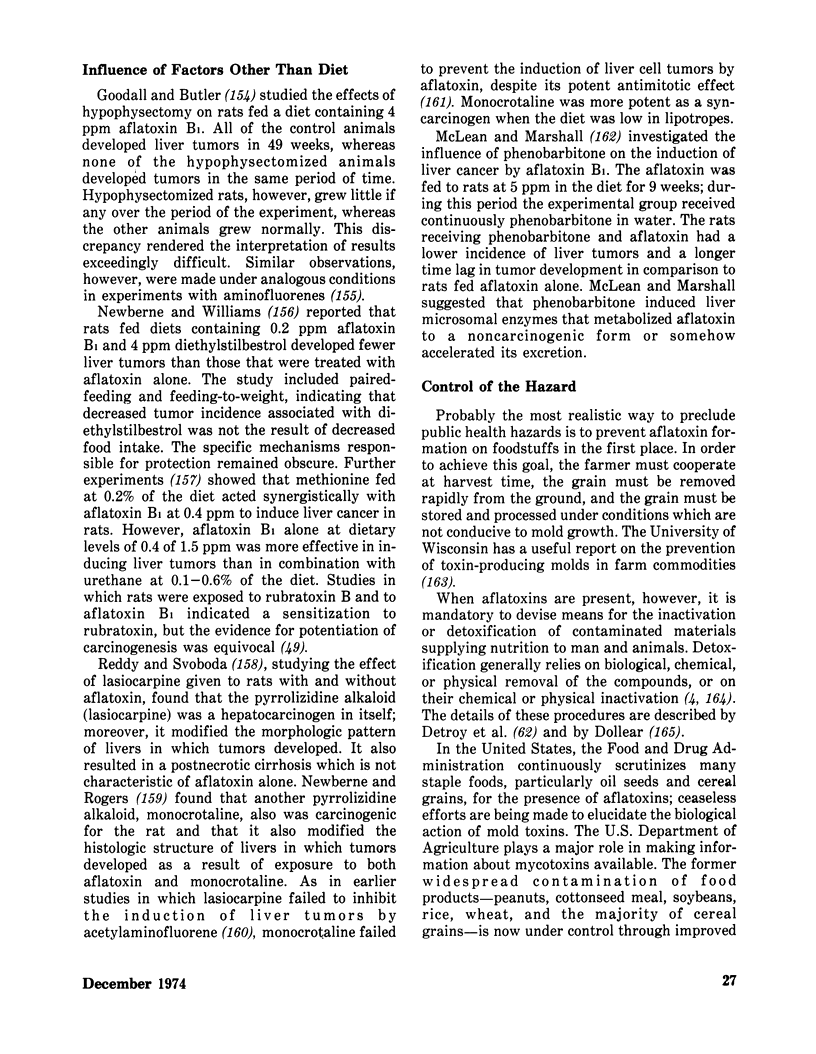
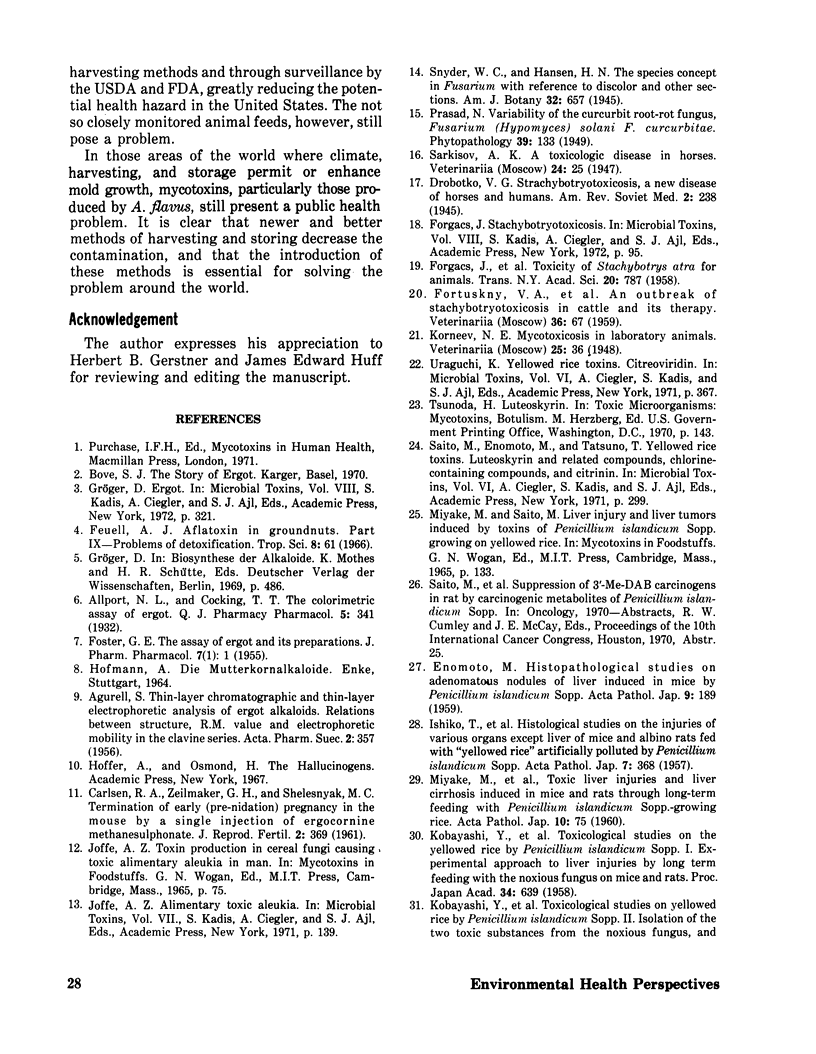
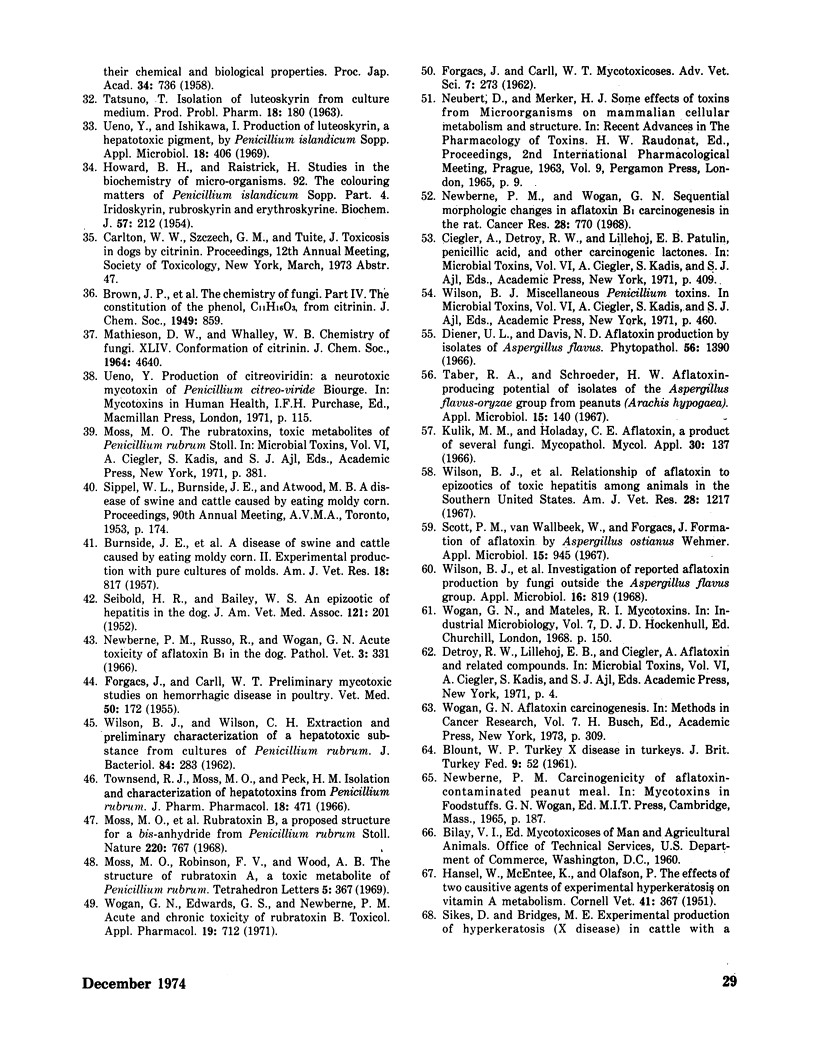
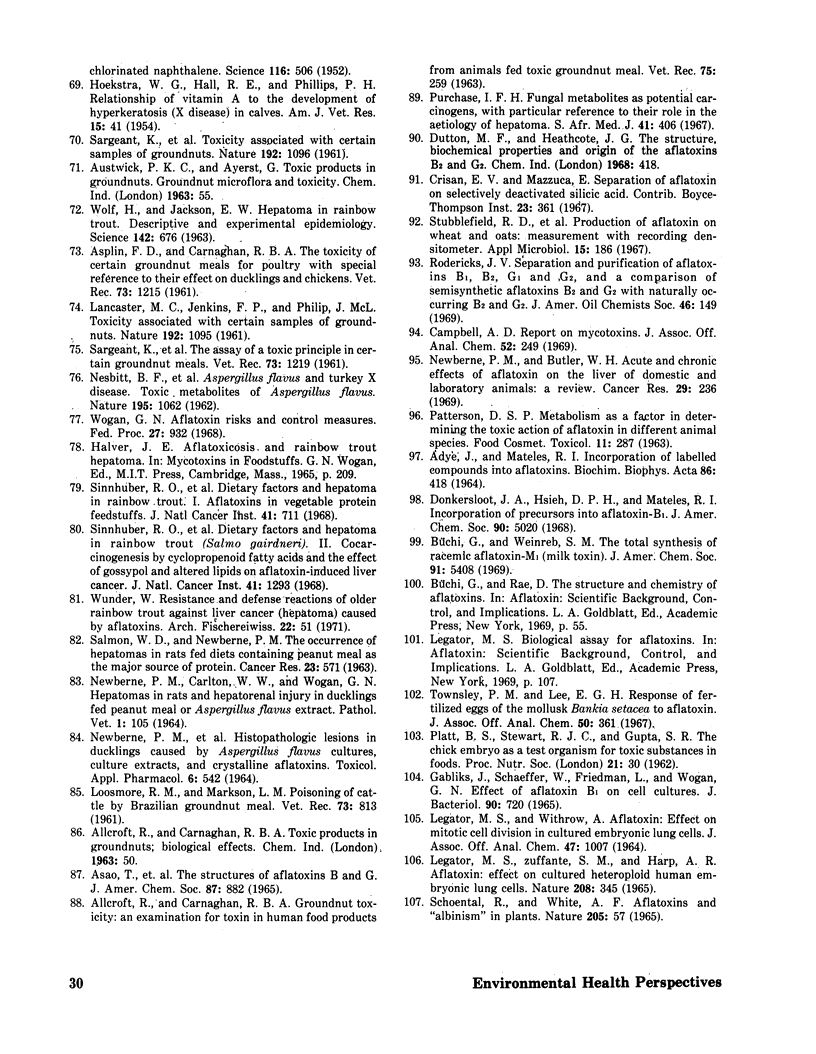
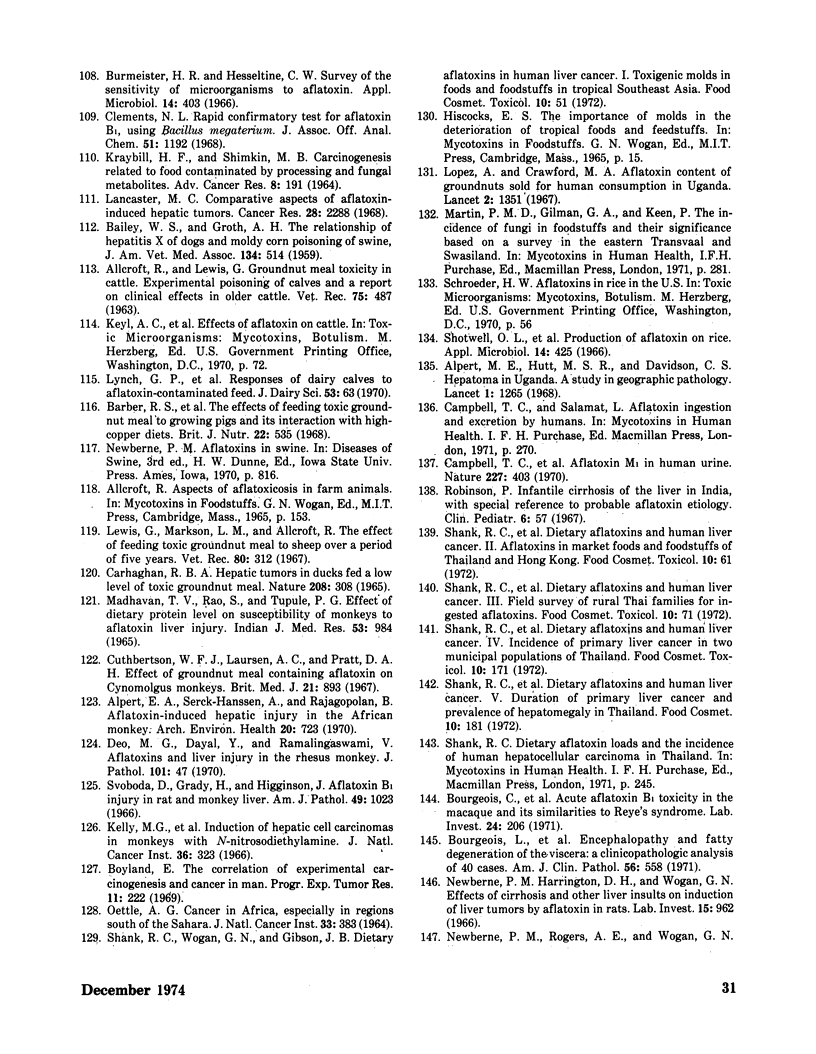

Images in this article
Selected References
These references are in PubMed. This may not be the complete list of references from this article.
- ADYE J., MATELES R. I. INCORPORATION OF LABELLED COMPOUNDS INTO AFLATOXINS. Biochim Biophys Acta. 1964 May 11;86:418–420. doi: 10.1016/0304-4165(64)90077-7. [DOI] [PubMed] [Google Scholar]
- ASAO T., BUECHI G., ABDEL-KADER M. M., CHANG S. B., WICK E. L., WOGAN G. N. THE STRUCTURES OF AFLATOXINS B AND G. J Am Chem Soc. 1965 Feb 20;87:882–886. doi: 10.1021/ja01082a031. [DOI] [PubMed] [Google Scholar]
- Agurell S. Thin-layer chromatographic and thin-layer electrophoretic analysis of ergot alkaloids. Relations between structure, RM value and electrophoretic mobility in the clavine series. Acta Pharm Suec. 1965 Nov;2(5):357–374. [PubMed] [Google Scholar]
- Alpert E., Serck-Hanssen A., Rajagopolan B. Aflatoxin-induced hepatic injury in the African monkey. Arch Environ Health. 1970 Jun;20(6):723–728. doi: 10.1080/00039896.1970.10665650. [DOI] [PubMed] [Google Scholar]
- Alpert M. E., Hutt M. S., Davidson C. S. Hepatoma in Uganda. A study in geographic pathology. Lancet. 1968 Jun 15;1(7555):1265–1267. doi: 10.1016/s0140-6736(68)92288-5. [DOI] [PubMed] [Google Scholar]
- BAILEY W. S., GROTH A. H., Jr The relationship of hepatitis X of dogs and moldy corn poisoning of swine. J Am Vet Med Assoc. 1959 Jun 1;134(11):514–516. [PubMed] [Google Scholar]
- BURNSIDE J. E., SIPPEL W. L., FORGACS J., CARLL W. T., ATWOOD M. B., DOLL E. R. A disease of swine and cattle caused by eating moldy corn. II. Experimental production with pure cultures of molds. Am J Vet Res. 1957 Oct;18(69):817–824. [PubMed] [Google Scholar]
- Barber R. S., Braude R., Mitchell K. G., Harding J. D., Lewis G., Loosmore R. M. The effects of feeding toxic groundnut meal to growing pigs and its interaction with high-copper diets. Br J Nutr. 1968 Dec;22(4):535–554. doi: 10.1079/bjn19680064. [DOI] [PubMed] [Google Scholar]
- Bourgeois C. H., Shank R. C., Grossman R. A., Johnsen D. O., Wooding W. L., Chandavimol P. Acute aflatoxin B1 toxicity in the macaque and its similarities to Reye's syndrome. Lab Invest. 1971 Mar;24(3):206–216. [PubMed] [Google Scholar]
- Bourgeois C., Olson L., Comer D., Evans H., Keschamras N., Cotton R., Grossman R., Smith T. Encephalopathy and fatty degeneration of the viscera: a clinicopathologic analysis of 40 cases. Am J Clin Pathol. 1971 Nov;56(5):558–571. doi: 10.1093/ajcp/56.5.558. [DOI] [PubMed] [Google Scholar]
- Boyland E. The correlation of experimental carcinogenesis and cancer in man. Prog Exp Tumor Res. 1969;11:222–234. doi: 10.1159/000391396. [DOI] [PubMed] [Google Scholar]
- Burmeister H. R., Hesseltine C. W. Survey of the sensitivity of microorganisms to aflatoxin. Appl Microbiol. 1966 May;14(3):403–404. doi: 10.1128/am.14.3.403-404.1966. [DOI] [PMC free article] [PubMed] [Google Scholar]
- Büchi G., Weinreb S. M. The total synthesis of racemic aflatoxin-M1 (milk toxin). J Am Chem Soc. 1969 Sep 10;91(19):5408–5409. doi: 10.1021/ja01047a052. [DOI] [PubMed] [Google Scholar]
- CARLSEN R. A., ZEILMAKER G. H., SHELESNYAK M. C. Termination of early (pre-nidation) pregnancy in the mouse by single injection of ergocornine methanesulphonate. J Reprod Fertil. 1961 Nov;2:369–373. doi: 10.1530/jrf.0.0020369. [DOI] [PubMed] [Google Scholar]
- Campbell T. C., Caedo J. P., Jr, Bulatao-Jayme J., Salamat L., Engel R. W. Aflatoxin M1 in human urine. Nature. 1970 Jul 25;227(5256):403–404. doi: 10.1038/227403a0. [DOI] [PubMed] [Google Scholar]
- Carnaghan R. B. Hepatic tumours in ducks fed a low level of toxic groundnut meal. Nature. 1965 Oct 16;208(5007):308–308. doi: 10.1038/208308a0. [DOI] [PubMed] [Google Scholar]
- Coomes T. J., Crowther P. C., Feuell A. J., Francis B. J. Experimental detoxification of groundnut meals containing aflatoxin. Nature. 1966 Jan 22;209(5021):406–407. doi: 10.1038/209406a0. [DOI] [PubMed] [Google Scholar]
- Deo M. G., Dayal Y., Ramalingaswami V. Aflatoxins and liver injury in the rhesus monkey. J Pathol. 1970 May;101(1):47–56. doi: 10.1002/path.1711010106. [DOI] [PubMed] [Google Scholar]
- Diener U. L., Davis N. D. Aflatoxin production by isolates of Aspergillus flavus. Phytopathology. 1966 Dec;56(12):1390–1393. [PubMed] [Google Scholar]
- Donkersloot J. A., Hsieh D. P., Mateles R. I. Incorporation of precursors into aflatoxin-B1. J Am Chem Soc. 1968 Aug 28;90(18):5020–5021. doi: 10.1021/ja01020a044. [DOI] [PubMed] [Google Scholar]
- Dutton M. F., Heathcote J. G. The structure, biochemical properties and origin of the aflatoxins B2a and G2a. Chem Ind. 1968 Mar 30;13:418–421. [PubMed] [Google Scholar]
- FORGACS J., CARLL W. T., HERRING A. S., HINSHAW W. R. Toxicity of Stachybotrys atra for animals. Trans N Y Acad Sci. 1958 Jun;20(8):787–808. doi: 10.1111/j.2164-0947.1958.tb00638.x. [DOI] [PubMed] [Google Scholar]
- FOSTER G. E. The assay of ergot and its preparations. J Pharm Pharmacol. 1955 Jan;7(1):1–15. doi: 10.1111/j.2042-7158.1955.tb11998.x. [DOI] [PubMed] [Google Scholar]
- Gabliks J., Schaeffer W., Friedman L., Wogan G. Effect of Aflatoxin B(1) on Cell Cultures. J Bacteriol. 1965 Sep;90(3):720–723. doi: 10.1128/jb.90.3.720-723.1965. [DOI] [PMC free article] [PubMed] [Google Scholar]
- Goodall C. M., Butler W. H. Aflatoxin carcinogenesis: inhibition of liver cancer induction in hypophysectomized rats. Int J Cancer. 1969 Jul 15;4(4):422–429. doi: 10.1002/ijc.2910040407. [DOI] [PubMed] [Google Scholar]
- HANSEL W., McENTEE K., OLAFSON P. The effects of two causative agents of experimental hyperkeratosis on vitamin A metabolism. Cornell Vet. 1951 Oct;41(4):367–376. [PubMed] [Google Scholar]
- HOEKSTRA W. G., HALL R. E., PHILLIPS P. H. A study on the relationship of vitamin A to the development of hyperkeratosis (x disease) in calves. Am J Vet Res. 1954 Jan;15(54):41–46. [PubMed] [Google Scholar]
- HOWARD B. H., RAISTRICK H. Studies in the biochemistry of micro-organisms. 92. The colouring matters of Penicillium islandicum Sopp. 4. Iridoskyrin, rubroskyrin and erythroskyrine. Biochem J. 1954 Jun;57(2):212–222. doi: 10.1042/bj0570212. [DOI] [PMC free article] [PubMed] [Google Scholar]
- KRAYBILL H. F., SHIMKIN M. B. CARCINOGENESIS RELATED TO FOODS CONTAMINATED BY PROCESSING AND FUNGAL METABOLITES. Adv Cancer Res. 1964;8:191–248. doi: 10.1016/s0065-230x(08)60509-6. [DOI] [PubMed] [Google Scholar]
- Kelly M. G., O'Gara R. W., Adamson R. H., Gadekar K., Botkin C. C., Reese W. H., Jr, Kerber W. T. Induction of hepatic cell carcinomas in monkeys with N-nitrosodiethylamine. J Natl Cancer Inst. 1966 Feb;36(2):323–351. [PubMed] [Google Scholar]
- Kulik M. M., Holaday C. E. Aflatoxin: a metabolic product of several fungi. Mycopathol Mycol Appl. 1966 Nov 10;30(2):137–140. doi: 10.1007/BF02130360. [DOI] [PubMed] [Google Scholar]
- Lancaster M. C. Comparative aspects of aflatoxin-induced hepatic tumors. Cancer Res. 1968 Nov;28(11):2288–2292. [PubMed] [Google Scholar]
- Legator M. S., Zuffante S. M., Harp A. R. Aflatoxin: effect on cultured heteroploid human embryonic lung cells. Nature. 1965 Oct 23;208(5008):345–347. doi: 10.1038/208345a0. [DOI] [PubMed] [Google Scholar]
- Lewis G., Markson L. M., Allcroft R. The effect of feeding toxic groundnut meal to sheep over a period of five years. Vet Rec. 1967 Mar 4;80(9):312–314. doi: 10.1136/vr.80.9.312. [DOI] [PubMed] [Google Scholar]
- Lopez A., Crawford M. A. Aflatoxin content of groundnuts sold for human consumption in Uganda. Lancet. 1967 Dec 23;2(7530):1351–1354. doi: 10.1016/s0140-6736(67)90934-8. [DOI] [PubMed] [Google Scholar]
- Lynch G. P., Todd G. C., Shalkop W. T., Moore L. A. Responses of dairy calves to aflatoxin-contaminated feed. J Dairy Sci. 1970 Jan;53(1):63–71. doi: 10.3168/jds.S0022-0302(70)86149-5. [DOI] [PubMed] [Google Scholar]
- Madhavan T. V., Gopalan C. The effect of dietary protein on carcinogenesis of aflatoxin. Arch Pathol. 1968 Feb;85(2):133–137. [PubMed] [Google Scholar]
- Madhavan T. V., Rao K. S., Tulpule P. G. Effect of dietary protein level on susceptibility of monkeys to aflatoxin liver injury. Indian J Med Res. 1965 Oct;53(10):984–989. [PubMed] [Google Scholar]
- Moss M. O., Robinson F. V., Wood A. B., Paisley H. M., Feeney J. Rubratoxin B, a proposed structure for a bis-anhydride rom Penicillium rubrum Stoll. Nature. 1968 Nov 23;220(5169):767–770. doi: 10.1038/220767a0. [DOI] [PubMed] [Google Scholar]
- Moss M. O., Wood A. B., Robinson F. V. The structure of rubratoxin A, a toxic metabolite of Penicillium rebrum. Tetrahedron Lett. 1969 Jan;(5):367–370. doi: 10.1016/s0040-4039(01)87693-0. [DOI] [PubMed] [Google Scholar]
- NESBITT B. F., O'KELLY J., SARGEANT K., SHERIDAN A. Aspergillus flavus and turkey X disease. Toxic metabolites of Aspergillus flavus. Nature. 1962 Sep 15;195:1062–1063. doi: 10.1038/1951062a0. [DOI] [PubMed] [Google Scholar]
- NEWBERNE P. M., WOGAN G. N., CARLTON W. W., ABDELKADER M. M. HISTOPATHOLOGIC LESIONS IN DUCKLINGS CAUSED BY ASPERGILLUS FLAVUS CULTURES, CULTURE EXTRACTS, AND CRYSTALLINE AFLATOXINS. Toxicol Appl Pharmacol. 1964 Sep;6:542–556. doi: 10.1016/0041-008x(64)90086-9. [DOI] [PubMed] [Google Scholar]
- Newberne P. M., Butler W. H. Acute and chronic effects of aflatoxin on the liver of domestic and laboratory animals: a review. Cancer Res. 1969 Jan;29(1):236–250. [PubMed] [Google Scholar]
- Newberne P. M., Harrington D. H., Wogan G. N. Effects of cirrhosis and other liver insults on induction of liver tumors by aflatoxin in rats. Lab Invest. 1966 Jun;15(6):962–969. [PubMed] [Google Scholar]
- Newberne P. M., Rogers A. E. Rat colon carcinomas associated with aflatoxin and marginal vitamin A. J Natl Cancer Inst. 1973 Feb;50(2):439–448. doi: 10.1093/jnci/50.2.439. [DOI] [PubMed] [Google Scholar]
- Newberne P. M., Russo R., Wogan G. N. Acute toxicity of aflatoxin B1 in the dog. Pathol Vet. 1966;3(4):331–340. doi: 10.1177/030098586600300403. [DOI] [PubMed] [Google Scholar]
- Newberne P. M., Williams G. Inhibition of aflatoxin carcinogenesis by diethylstilbestrol in male rats. Arch Environ Health. 1969 Oct;19(4):489–498. doi: 10.1080/00039896.1969.10666874. [DOI] [PubMed] [Google Scholar]
- Newberne P. M., Wogan G. N. Sequential morphologic changes in aflatoxin B carcinogenesis in the rat. Cancer Res. 1968 Apr;28(4):770–781. [PubMed] [Google Scholar]
- OETTLE A. G. CANCER IN AFRICA, ESPECIALLY IN REGIONS SOUTH OF THE SAHARA. J Natl Cancer Inst. 1964 Sep;33:383–439. [PubMed] [Google Scholar]
- Patterson D. S. Metabolism as a factor in determining the toxic action of the aflatoxins in different animal species. Food Cosmet Toxicol. 1973 Apr;11(2):287–294. doi: 10.1016/s0015-6264(73)80496-1. [DOI] [PubMed] [Google Scholar]
- Purchase I. F. Fungal metabolites as potential carcinogens, with particular reference to their role in the aetiology of hepatoma. S Afr Med J. 1967 Apr 22;41(16):406–413. [PubMed] [Google Scholar]
- Reddy J. K., Svoboda D. Effect of lasiocarpine on aflatoxin B 1 carcinogenicity in rat liver. Arch Pathol. 1972 Jan;93(1):55–60. [PubMed] [Google Scholar]
- Robinson P. Infantile cirrhosis of the liver in India, with special reference to probable aflatoxin etiology. Clin Pediatr (Phila) 1967 Jan;6(1):57–62. doi: 10.1177/000992286700600116. [DOI] [PubMed] [Google Scholar]
- Rogers A. E., Newberne P. M. Aflatoxin B1 carcinogenesis in lipotrope-deficient rats. Cancer Res. 1969 Nov;29(11):1965–1972. [PubMed] [Google Scholar]
- Rogers A. E., Newberne P. M. Lasiocarpine: factors influencing its toxicity and effects on liver cell division. Toxicol Appl Pharmacol. 1971 Feb;18(2):356–366. doi: 10.1016/0041-008x(71)90128-1. [DOI] [PubMed] [Google Scholar]
- Rogers A. E., Newberne P. M. Nutrition and aflatoxin carcinogenesis. Nature. 1971 Jan 1;229(5279):62–63. doi: 10.1038/229062a0. [DOI] [PubMed] [Google Scholar]
- SIEBOLD H. R., BAILEY W. S. An epizootic of hepatitis in the dog. J Am Vet Med Assoc. 1952 Sep;121(906):201–206. [PubMed] [Google Scholar]
- Scott P. M., van Walbeek W., Forgacs J. Formation of aflatoxins by Aspergillus ostianus Wehmer. Appl Microbiol. 1967 Jul;15(4):945–945. doi: 10.1128/am.15.4.945-.1967. [DOI] [PMC free article] [PubMed] [Google Scholar]
- Shank R. C., Bhamarapravati N., Gordon J. E., Wogan G. N. Dietary aflatoxins and human liver cancer. IV. Incidence of primary liver cancer in two municipal populations of Thailand. Food Cosmet Toxicol. 1972 Apr;10(2):171–179. doi: 10.1016/s0015-6264(72)80195-0. [DOI] [PubMed] [Google Scholar]
- Shank R. C., Siddhichai P., Subhamani B., Bhamarapravati N., Gordon J. E., Wogan G. N. Dietary aflatoxins and human liver cancer. V. Duration of primary liver cancer and prevalence of hepatomegaly in Thailand. Food Cosmet Toxicol. 1972 Apr;10(2):181–191. doi: 10.1016/s0015-6264(72)80196-2. [DOI] [PubMed] [Google Scholar]
- Shirasu Y., Grantham P. H., Yamamoto R. S., Weisburger J. H. Effects of pituitary hormones and prefeeding N-hydroxy-N-2-fluorenylacetamide on the metabolism of this carcinogen and on physiologic parameters. Cancer Res. 1966 Apr;26(4):600–606. [PubMed] [Google Scholar]
- Shotwell O. L., Hesseltine C. W., Stubblefield R. D., Sorenson W. G. Production of aflatoxin on rice. Appl Microbiol. 1966 May;14(3):425–428. doi: 10.1128/am.14.3.425-428.1966. [DOI] [PMC free article] [PubMed] [Google Scholar]
- Sinnhuber R. O., Lee D. J., Wales J. H., Ayres J. L. Dietary factors and hepatoma in rainbow trout (Salmo gairdneri). II. Cocarcinogenes by cyclopropenoid fatty acids and the effect of gossypol and altered lipids on aflatoxin-induced liver cancer. J Natl Cancer Inst. 1968 Dec;41(6):1293–1301. [PubMed] [Google Scholar]
- Sinnhuber R. O., Wales J. H., Ayres J. L., Engebrecht R. H., Amend D. L. Dietary factors and hepatoma in rainbow trout (Salmo gairdneri). I. Aflatoxins in vegetable protein feedstuffs. J Natl Cancer Inst. 1968 Sep;41(3):711–718. [PubMed] [Google Scholar]
- Stubblefield R. D., Shotwell O. L., Hesseltine C. W., Smith M. L., Hall H. H. Production of aflatoxin on wheat and oats: measurement with a recording densitometer. Appl Microbiol. 1967 Jan;15(1):186–190. doi: 10.1128/am.15.1.186-190.1967. [DOI] [PMC free article] [PubMed] [Google Scholar]
- Svoboda D., Grady H. J., Higginson J. Aflatoxin B1 injury in rat and monkey liver. Am J Pathol. 1966 Dec;49(6):1023–1051. [PMC free article] [PubMed] [Google Scholar]
- TATSUNO T. [Biochemical research on the toxic substances of rice yellowed by Penicillium islandicum Sopp]. Prod Pharm. 1963 Apr;18:180–186. [PubMed] [Google Scholar]
- Taber R. A., Schroeder H. W. Aflatoxin-producing potential of isolates of the Aspergillus flavus-oryzae group from peanuts (Arachis hypogaea). Appl Microbiol. 1967 Jan;15(1):140–144. doi: 10.1128/am.15.1.140-144.1967. [DOI] [PMC free article] [PubMed] [Google Scholar]
- Townsend R. J., Moss M. O., Peck H. M. Isolation and characterisation of hepatotoxins from Penicillum rubrum. J Pharm Pharmacol. 1966 Jul;18(7):471–473. doi: 10.1111/j.2042-7158.1966.tb07908.x. [DOI] [PubMed] [Google Scholar]
- Ueno Y., Ishikawa I. Production of luteoskyrin, a hepatotoxic pigment, by Penicillium islandicum Sopp. Appl Microbiol. 1969 Sep;18(3):406–409. doi: 10.1128/am.18.3.406-409.1969. [DOI] [PMC free article] [PubMed] [Google Scholar]
- WILSON B. J., WILSON C. H. Extraction and preliminary characterization of a hepatotoxic substance from cultures of Penicillium rubrum. J Bacteriol. 1962 Aug;84:283–290. doi: 10.1128/jb.84.2.283-290.1962. [DOI] [PMC free article] [PubMed] [Google Scholar]
- WOLF H., JACKSON E. W. HEPATOMAS IN RAINBOW TROUT: DESCRIPTIVE AND EXPERIMENTAL EPIDEMIOLOGY. Science. 1963 Nov 8;142(3593):676–678. doi: 10.1126/science.142.3593.676-a. [DOI] [PubMed] [Google Scholar]
- Wilson B. J., Campbell T. C., Hayes A. W., Hanlin R. T. Investigation of reported aflatoxin production by fungi outside the Aspergillus flavus group. Appl Microbiol. 1968 Jun;16(6):819–821. doi: 10.1128/am.16.6.819-821.1968. [DOI] [PMC free article] [PubMed] [Google Scholar]
- Wilson B. J., Teer P. A., Barney G. H., Blood F. R. Relationship of aflatoxin to epizootics of toxic hepatitis among animals in southern United States. Am J Vet Res. 1967 Sep;28(126):1217–1230. [PubMed] [Google Scholar]
- Wogan G. N. Aflatoxin risks and control measures. Fed Proc. 1968 May-Jun;27(3):932–938. [PubMed] [Google Scholar]
- Wogan G. N., Edwards G. S., Newberne P. M. Acute and chronic toxicity of rubratoxin B. Toxicol Appl Pharmacol. 1971 Aug;19(4):712–720. doi: 10.1016/0041-008x(71)90303-6. [DOI] [PubMed] [Google Scholar]



